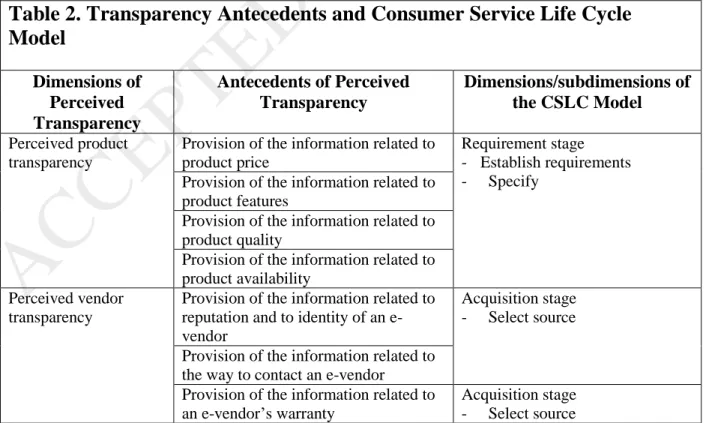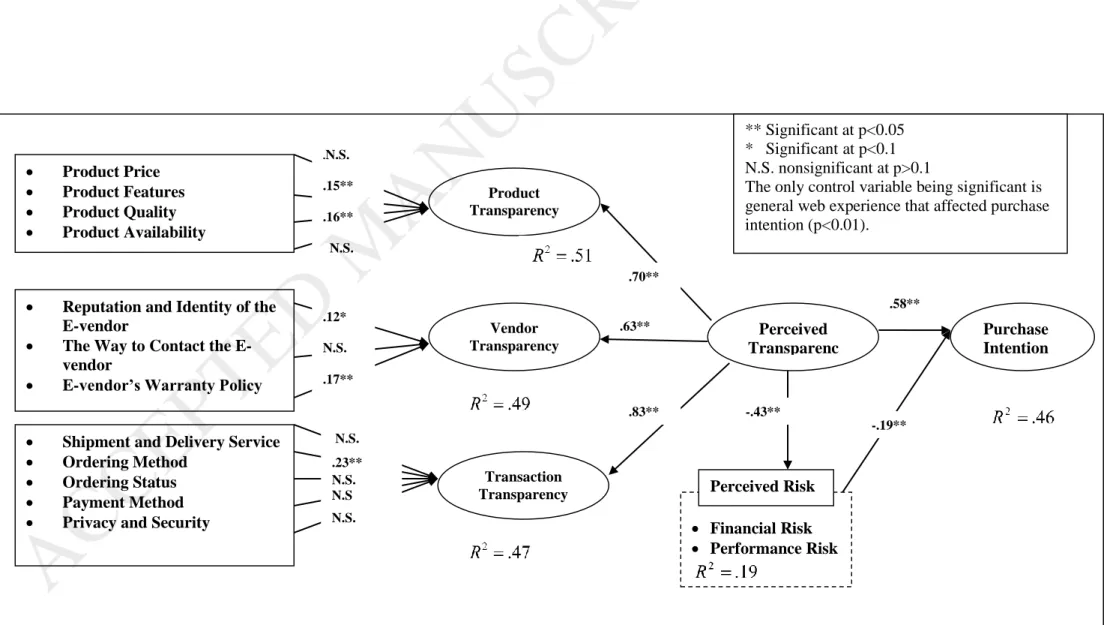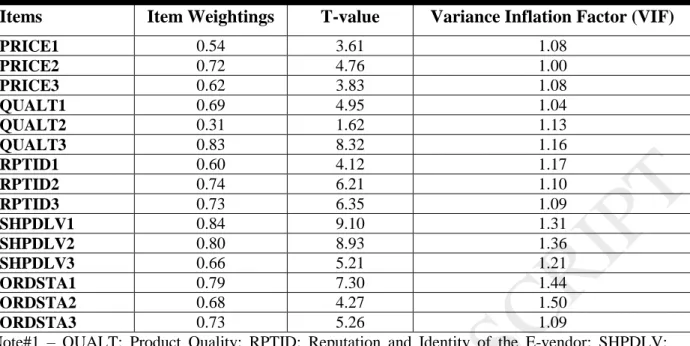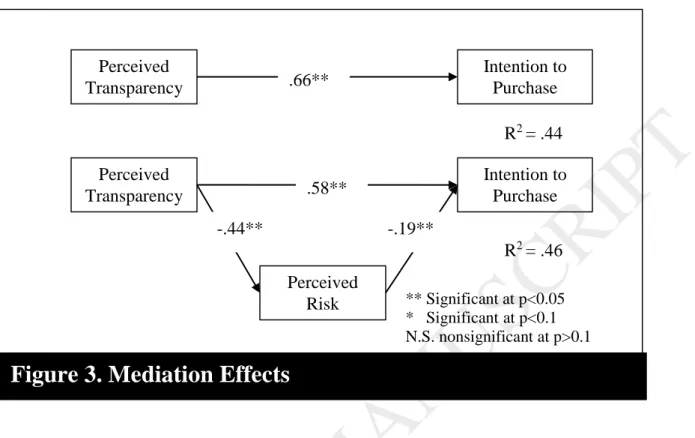Consumers abandon their online purchases on an e-commerce website in part because of the website's lack of information transparency. Anecdotal evidence shows that lack of information transparency is one of the top 10 factors that lead to consumers ultimately abandoning online shopping [2]. In the context of B2C e-commerce, information transparency is defined as the extent to which website information is available and accessible to consumers [32, 94].
How consumers' perceived transparency of information to a B2C e-commerce website affects their intention to purchase from the website. 6 specific effects of information precursors from the point of view of information transparency.2 Some included only one or two dimensions.

ACCEPTED MANUSCRIPT
Hypotheses Development
- Antecedents of Perceived Information Transparency
- Direct Effect of Perceived Transparency on the Intention to Purchase
- Indirect Effect of Perceived Transparency on Intention to Purchase Mediated by Perceived Risk
Similarly, e-vendors' contact information, including physical address and hotline links, also improves consumers' perceived transparency of the e-vendors [ 66 ]. H2: Provision of identity- (H2a), contact- (H2b) and warranty-related information (H2c) of the e-seller will positively influence consumers' perceived e-seller transparency. H3: Provision of transaction fulfillment related information [i.e. shipping and delivery service (H3a), order method (H3b), order status (H3c), payment method (H3d), and privacy and security policies (H3e)] on the B2C website will positively affect consumers' perceived transaction transparency.
Thus, this research considers perceived risk as a second-order construct (comprising two first-order constructs, namely, performance risk and financial risk) that determines consumers' purchase intention on a B2C e-commerce site. This alleviation of concerns can, in turn, reduce consumers' perceived risk of purchasing a product online and ultimately increase their purchase intention.

Method and Framework
- Measurement Development
- Websites, Participants, and Data Collection Procedure
Since the purpose of the first step in measure development was to ensure content validity [57], we invited seven participants (four students from the Department of English and Communication and four assistant professors in MIS) to generate enough candidate items. In addition, they had to write down their reasons if they thought that a certain object should not belong to any of the given constructions. Several factors previously shown to be related to perceived transparency, perceived risk and intention to purchase were measured in the background questionnaire before the experimental tasks, so that their effects on the three constructs could be controlled.
Experts with good knowledge of a product can better understand the related product information on the website and will therefore perceive a high level of product transparency compared to persons with little knowledge of the product. Repeat customers, based on their previous interactions with the e-vendor, should have a much better understanding of the e-vendor than first-time consumers. familiarity with the e-vendor may influence their perceived supplier transparency. To identify a pool of e-commerce sites for our scenario-based survey, a research assistant (RA), who was unaware of the purposes of this study, was instructed to use Google to search online stores for digital cameras and jackets search.
We considered both digital cameras and jackets to be the main products in the study, as they were considered typical respectively. To ensure the generalizability of the findings, we included both types of products in this study. We have not chosen those well-known websites to minimize the influence of the participants.'
Regarding the expected level of transparency, for example, the website http://www.digicombos.com/ provided very detailed pricing information, including the original price, tax and delivery charges, while the website www.onecall.com only offered total price without specifying specific components. 138 undergraduate students of a major university in Hong Kong participated in the study. During the process, participants were allowed to ask questions to ensure full understanding of the survey process.
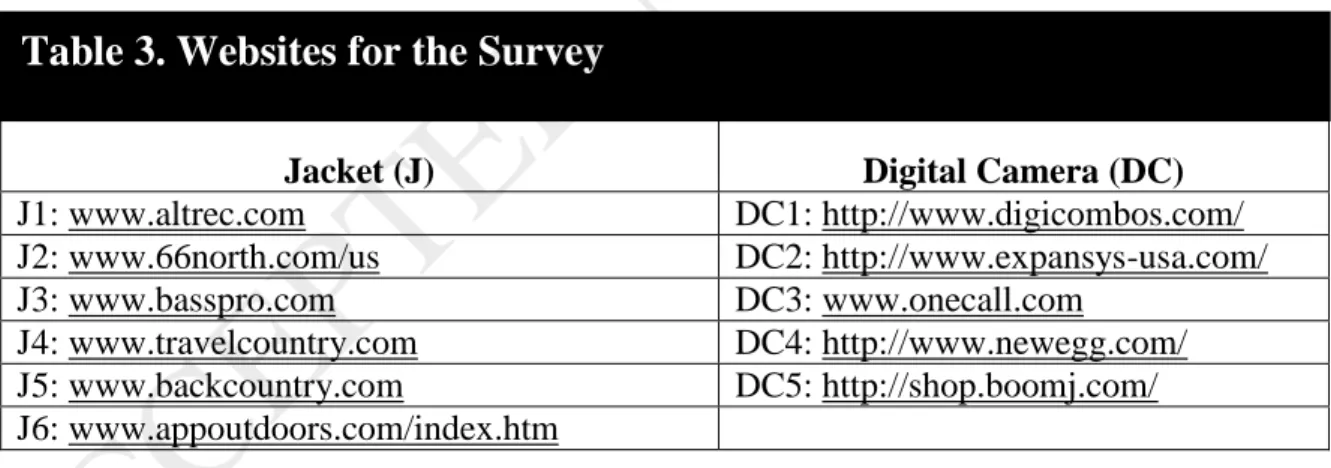
Data Analysis and Results
- Data Analysis for the Measurement Model
- Data Analysis for the Structural Model
PLS allows testing of higher order models by using the hierarchical component model [7, 24]. All reflective constructs show strong positive charges significant at the .001 level, indicating high reliability of individual items. Thus, a common factor analysis is inadequate for formative constructs because there is no requirement that the measures of the construct be highly correlated [70].
We decided to keep this item because it measures the essence of the construction: product quality. Note #2: The designation of a construct as formative or reflective depends on the nature of the construct. Two of the decision rules are whether or not the construct indicators should covary with each other and be interchangeable.
Furthermore, providing the information related to the reputation and identity of the e-seller (β= 0.12, p < 0.1) and e-seller's warranty policy (β= 0.17, p < 0.05) significantly increased the perceived supplier. The majority of the variance in intention to buy was explained by the direct effect of perceived transparency rather than the indirect effect. To examine the significance of the partial mediation, we performed the bootstrapping mediation test to examine the mediating role of perceived risk [ 63 ].
In addition, the direct effect of information transparency on purchase intention was also significant (p<0.01). In addition, the results of the structural model show the effects of the first-order dimensions on their second-order aggregate construction. The effect sizes of the rest of the subhypothesies of H1 and H3 are all less than 0.01.
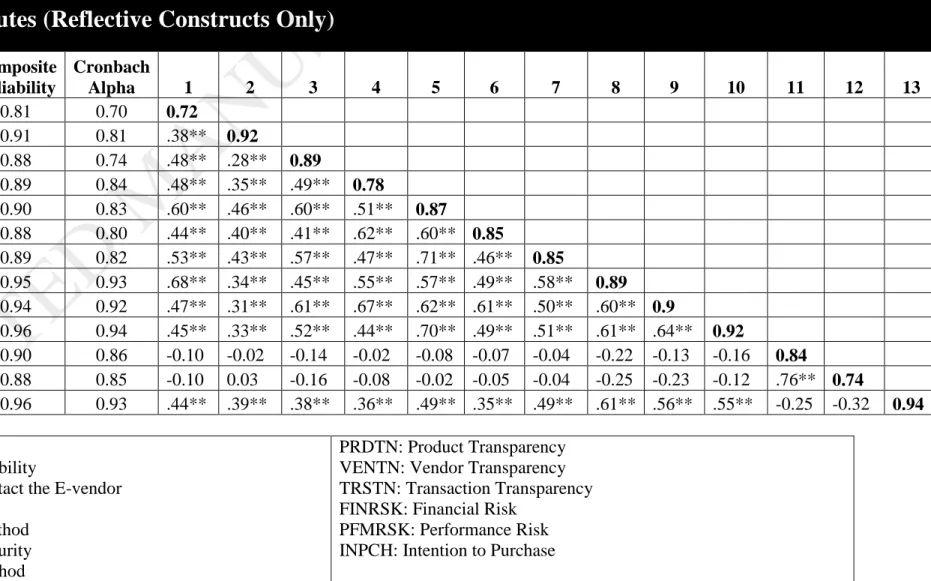
Discussion and Contributions
- Discussion
- Limitation and Suggestions for Future Research
- Contributions
- Theoretical Contributions
- Practical Contributions
Non-informative factors that influence consumers' perceived transparency certainly exist, but they were not included in this study. For example, the information format, which refers to how information is presented and organized (list versus matrix) on a website, can have a significant effect on consumers' information gathering and processing. Second, this research only focused on consumers' purchase intention as the main transparency outcomes, and as a result, we could not sufficiently generalize the positive effects of perceived transparency to other consumer behavioral intentions, such as consumer word-of-mouth (WOM). ) against a B2C e-commerce site.
Instead, we measured consumers' perceived information transparency because consumers are in a better position to judge whether they can clearly understand the information to meet their needs.3 Nevertheless, future research should examine the response of the. This study bridged the theoretical gap by building on the CSLC framework to identify consumers' information needs and developing a multidimensional construct with three subdimensions (perceived product transparency, perceived seller transparency and perceived transaction transparency). Many previous studies empirically validated the significant influence of information disclosure on consumers' perceived transparency, while this research further analyzed the type of information displayed on a B2C e-commerce website and how it generated consumers' perceived transparency.
The results suggest that not all information related to B2C e-commerce can improve consumers' perceived transparency of the websites. Third, this study proposed and empirically testified to an underlying mechanism by which perceived transparency influenced consumer purchase intention. Our study extends the agency perspective to the e-commerce environment by proposing perceived information transparency as an effective way to reduce information asymmetry between the principal and the agent and consequently reduce consumers' perceived risk and increase intention to purchase.
In particular, e-tailers now have a guide to capture consumers' real information needs, and by providing the information consumers really need on websites, e-tailers can more effectively increase consumers' perceived transparency of websites . For example, the results indicated that certain website information (ie, product quality and ordering methods) assumed more important roles in influencing consumers' perceived transparency compared to other types of information. Thus, to increase consumers' perceived transparency and encourage their purchase intention, e-tailers should weigh more heavily on these types of information and disclose them fully and clearly on websites.
The results of this research provided strong evidence to support the detrimental effects of lack of information transparency in B2C e-commerce, indicating that even if e-tailers could successfully maintain their information advantage, they could still suffer financial losses from the omission. consumers their purchase if there is no transparency of information. Research into the effectiveness of color and graphic presentation of information in different time constraints. In, Bharadwaj, A., Narasimhan, S., and Sauthanam, R., (Eds.), Proceedings of the 8th INFORMS Conference on Information Systems and Technology, Atlanta, GA, 2003.
Orbitz, online travel agents, and market structure changes in the presence of technology-driven market transparency. The Effects of Information Format and Shopping Task on Consumers' Online Shopping Behavior: A Cognitive Fit Perspective. The firm intention of group buying websites: Integrating the commitment-trust theory and e-commerce success model.
Weiquan Wang is a professor in the Department of Information Systems at the City University of Hong Kong. His works have been published in Information Systems Research, Journal of Management Information Systems, MIS Quarterly, Management Science, Journal of Association for Information Systems, among others. Jingjun (David) Xu is an Associate Professor in the Department of Information Systems at the City University of Hong Kong.
He has published papers in MIS Quarterly, Information Systems Research, Journal of the Association for Information Systems, Journal of Strategic Information Systems, Journal of Business Ethics, Information &. University of Hong Kong – University of Science and Technology of China Joint Advanced Research Center. Jibao Gu is a professor in the Department of Business Administration at the University of Science and Technology of China.
Appendix A: Measurement Items
The website provided the service policies for its consumers, such as installation and maintenance services. Detailed instructions for requesting installation and maintenance services were provided on the website. I believe that the purchase of the product would create a financial risk for me, due to the possibility of higher maintenance and repair costs.
Given the potential costs associated with purchasing the product, much risk is associated with purchasing the product. I would worry that I might not get my money's worth out of the product when I buy it. Considering the possible problems related to the performance of the product, a great risk would be involved in purchasing the product from the e-store.
There is too much uncertainty about the performance of the product from the e-store. I would be afraid that the product would not give me the benefits I expected it to. On average, how much time per week do you spend on each of the following web activities?
Appendix B. Factor Loadings and Cross-Loadings (Reflective constructs Only)
